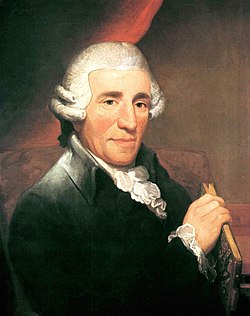Movements
- Allegro
- Andante, 6
8 - Menuet & Trio, 3
4 - Finale: Andante (Thema. Var. I–VI), 2
4 — Presto, 6
8
The horns are silent in the second movement. In their place are solo passages for flute and violin. [3]
The minuet begins and ends with the same phrase piano with the ending as an echo. The strings are silent in the trio which is scored for all the winds minus the flute. [2]
The finale is a set of marching variations that features many soloists accompanied by strings. The first variation features solo flute, the second a solo cello, the third a solo violin and the fourth a solo violone. The fifth variation is scored for oboe, two horns and strings while the sixth variation is for flute, oboe, bassoon, four horns and strings. The movement concludes with a Presto coda in 6
8 and featuring a final horn flourish. [3]
This page is based on this
Wikipedia article Text is available under the
CC BY-SA 4.0 license; additional terms may apply.
Images, videos and audio are available under their respective licenses.
